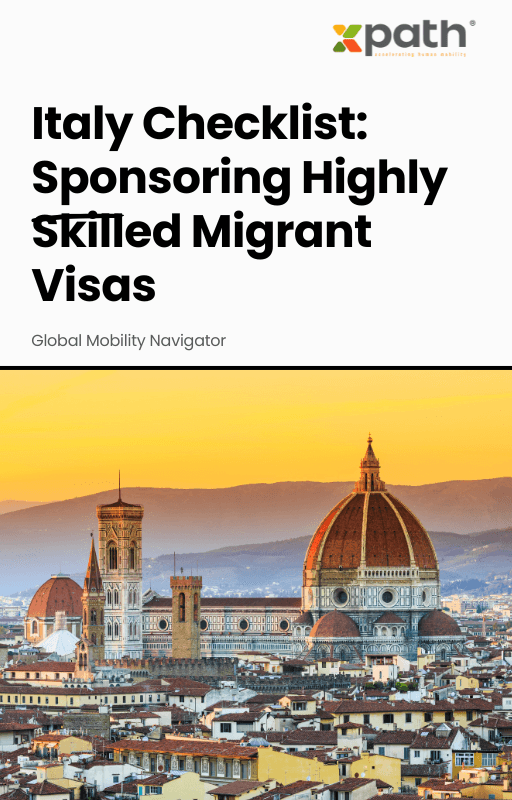Italy Checklist: Sponsoring Highly Skilled Migrant Visas
Grab a copy of a guide to international employee relocation
View E-bookNavigating the labyrinth of international assignments and employee relocations can feel overwhelming for even the most seasoned HR professional. But what if you could bring clarity, consistency, and cost-efficiency to the table — all at once? That’s where a tiered global mobility policy steps in. As businesses rapidly expand across borders, tailoring mobility packages to fit the diverse needs of your workforce isn’t just smart; it’s essential. Let’s explore how to design a tiered global mobility policy that delights employees and aligns with business goals.
In today’s boundaryless business world, global mobility isn’t a luxury—it’s a lifeline. According to a 2023 Worldwide ERC report, over 56% of multinational companies plan to increase the number of global assignments within the next three years. With such exponential growth, it’s no wonder that one-size-fits-all relocation packages are fast becoming extinct.
Many organizations are grappling with how to balance talent expectations, budget constraints, and compliance requirements. The secret sauce? Structured, tiered policies. These frameworks introduce a hierarchy of support levels depending on factors like job role, assignment type, and business criticality. Think of it as designing a menu, not a rigid prix-fixe. And employee satisfaction soars when they sense their unique needs have been anticipated and met.
A tiered mobility policy is a structured approach where relocation benefits and support are categorized into different levels, or “tiers.” Each tier corresponds to specific assignment types, employee groups, or business objectives. For instance, a senior executive on a five-year leadership assignment might receive a platinum package—think comprehensive support for everything from household goods to schooling for children. Meanwhile, a short-term project consultant might qualify for a simpler support tier optimized for agility and cost-savings.
This not only ensures fairness but also gives organizations a clear framework for decision-making, minimizing exceptions and “policy creep,” which, as mobility managers know all too well, can spiral costs out of control.
The mobility landscape is shifting rapidly. Deloitte’s “2023 Global Workforce Mobility Trends” survey found that 47% of global companies have transitioned to a tiered or segmented policy model. Here’s why:
Organizations are striving for flexibility amidst rising cost pressures and more diverse mobility demands. The modern workforce is multigenerational, and employee expectations are evolving in tandem with business objectives. By structuring policies, companies can right-size resources—providing robust support for mission-critical assignments while staying nimble for short-term moves. Technology platforms like xpath.global have further accelerated this trend, offering comprehensive tools to operationalize and manage tiered policies digitally, ensuring compliance and data-driven decisions.
So, how do you architect a policy that works for both business and employee? Start with a deep dive into assignment types and stakeholder needs. Segment assignments by duration, strategic importance, location risk, and employee level. A typical policy might have three to four tiers: executive/leadership, experienced professionals, early-career mobility, and project-based/short-term roles.
Next, engage key stakeholders—HR, business unit leaders, finance, and your relocation management partner—to agree on the value offered at each level. Determine non-negotiables (like security or compliance) and where flexibility can be introduced (such as lump sums or menu-style benefits).
Finally, document and communicate the policy clearly. Use technology platforms to automate processes, track assignment data, and provide visibility for all stakeholders. With xpath.global, for example, customizable workflows and analytics streamline administration, making policy management almost frictionless.
Implementing a tiered policy isn’t without its speedbumps. One major challenge is ensuring perceived equity—junior employees shouldn’t feel short-changed, nor should senior leaders expect excessive benefits. Transparent communication and data-driven rationale underpin the most successful policies.
Another pitfall is underestimating the policy administration workload. Multiple tiers mean more moving parts, which can bog down HR teams reliant on spreadsheets or outdated systems. This is where centralized platforms like xpath.global shine: automating assignment workflows, keeping records clean, and surfacing insights for continuous improvement.
Lastly, don’t let your policy stagnate. The global landscape shifts rapidly—think inflation, changing tax regimes, or geopolitical upheaval. Build in regular reviews, informed by assignment and cost data, to keep your policy aligned with both market trends and employee expectations.
Consider the example of a multinational tech giant that overhauled their mobility program with a tiered policy framework. Facing assignment costs that were spiraling and employee satisfaction that was dipping, their HR team collaborated with xpath.global to redesign their approach.
By segmenting assignments into executive, mid-level, and short-term tiers—and leveraging xpath.global’s policy management suite—they cut administrative time by 45%, reduced exception requests by 38%, and boosted employee satisfaction scores by 21% in relocation feedback surveys. The tech giant now tracks assignment success in real-time, iterating offerings based on actionable data instead of intuition.
Designing a tiered global mobility policy isn’t a “set it and forget it” exercise—it’s more like tuning a finely crafted instrument. Start small, pilot a few tiers, gather feedback, and use platforms like xpath.global to monitor uptake and costs. Involve your employees throughout, soliciting their input and adapting offerings to ensure each person feels valued and understood. Your ultimate goal? An agile, transparent, and equitable mobility program that grows with your business and your people.
What factors should I consider when creating tiers?
Assignment duration, employee seniority, type of move (permanent vs. short-term), business unit needs, and the criticality of the role all matter.
How do I balance cost and employee experience?
By defining core (non-negotiable) versus flexible (customizable) benefits and using data/feedback to iterate. A platform like xpath.global can help track satisfaction and cost data side by side.
How often should I revisit my policy tiers?
At least annually, or whenever there are significant business, economic, or regulatory changes.
Can I use technology to streamline policy administration?
Absolutely. Integrated solutions like xpath.global automate workflows, centralize communications, help manage vendors, and ensure compliance across jurisdictions.
Ready to transform your mobility program? Explore xpath.global’s solutions.

Italy Checklist: Sponsoring Highly Skilled Migrant Visas
Grab a copy of a guide to international employee relocation
View E-book